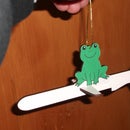Introduction: Repairing Broken Handle on Garden Waste Bucket
I had a big plastic bucket which was used for hauling clippings and assorted detritus around the garden. It was useful enough, but it was a bit on the small side and then one of the handles broke.
So, time to fix two problems with one repair. The plastic of the bucket was very thin, so just using solvents or heat to weld the split wouldn't have worked for very long which meant I decided to add new handles. Again due to the flimsy structure of the bucket, the handles would require a means of spreading the stress at their attachment points.
The plan was to make the new handles longer than the originals which would allow larger loads in the bucket. (and hence fewer trips to the compost heap).
The second photograph above shows the completed project. The bucket is full of agapanthus (I hate agapanthus) and it contains about twice as much as would have fitted before.
Step 1: Materials and Design
I had a scrap strip of flexible plywood, so I decided to use that to match the curve of the bucket, although more and shorter pieces of thin ply would have worked just as well.
The general idea was to have two strips of flexible plywood, one inside the bucket and one outside. They would help to spread the force of screws being driven through both layers of ply to bit into small wooden blocks on the inside.
The handles would be made from a fairly strong polyester cord (I had no paracord kicking about) with grips made from a couple of scraps of smooth hardwood which I had.
To give nice smooth holes through the plastic, and to reduce the chance of any rough edges fraying the cord or providing stress points for the plastic to tear, I was going to melt the holes through the bucket rather than drill them.
Step 2: Cutting the Wood
Cut the ply into four equal chunks.
Cut eight small pieces of scrap wood to receive the driven screws and drill pilot holes in them.
Drill holes in the ply for the screws to pass through, and larger ones for the cord.
Step 3: Drilling Clearance Holes in the Rim of the Bucket
Preheat the soldering iron. I recommend that you use one which won't be later required for electronics work. At the very least have a sacrificial tip which you don't mind not using for electronics again.
Clamp the drilled strips in place and use the hot tip of the iron to mark the plastic. The bit probably won't penetrate all the way through as the holes in the ply are quite small, but it's enough that it melts a little bit of the surface.
Once all the holes have been marked, demount the ply and use the soldering iron to go right through the plastic at the points marked. Remember to make the two holes for the cord large enough that you'll be able to thread the cord through.
Step 4: Fix Strips to Bucket
This one is a bit fiddly if you only have two hands, but conceptually it's pretty simple:- drive the screws through the outside ply, the bucket and the inside ply into the small wooden blocks.
Step 5: Making and Fitting the Handles
Cut two lengths of cord, and seal the ends with heat to prevent fraying. Make the cord long enough that the handles will meet in the middle of the bucket when it is not distorted from circular, but not so long that the bucket scrapes the ground when you are holding the handles.
Thread the cord through the two layers of ply and the plastic of the bucket. This is the point at which you wish you had remembered to check clearances.
Tie the cord off at the handles. There were already counterbored holes in the scrap hardwood I was using, so a nice figure-8 stopper knot did the trick nicely.
Job done.













